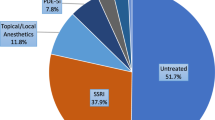Abstract
Aims of this study: To evaluate the efficacy of chronic and ‘on demand’ administration of paroxetine hydrochloride in the drug treatment of premature ejaculation (PE).
Materials and methods: Ninety-four normally potent men, aged 18–61 y (mean 39 y) with premature ejaculation were treated between January 1996 and March 1997, with oral paroxetine hydrochloride, a selective serotonin re-uptake inhibitor (SSRI). All men were either married or in a stable relationship. Sixty-four out of ninety-four men (Group A) were initially treated with paroxetine hydrochloride 20 mg administered once daily. Those men who responded with improved ejaculatory control within four weeks, were then treated with ‘on-demand’ paroxetine hydrochloride (20 mg) administered 3–4 h prior to planned intercourse. The remaining 33 out of 94 men (Group B) were initially treated with ‘on-demand’ paroxetine hydrochloride 20 mg administered 3–4 h prior to planned intercourse.
Results: The mean pre-treatment ejaculatory latency time (ELT) of both group A and B was 0.4 min (range 0–1 min) in 205 intercourses at a frequency of 0.4 intercourses PEr week. In group A after four weeks of daily administration of paroxetine, the mean ELT was 4.5 min (range 1-anejac.) in 761 intercourses at a frequency of 2.4 intercourses per week. Fifty-three out of sixty-one men in group A regarded their ejaculatory control as improved and were then treated with ‘on-demand’ paroxetine, achieving an ELT of 3.9 min (range 0–10) in 608 intercourses at a frequency of 2.6 intercourses per week. Thirty-six men in this group of 53 regarded that they had maintained improved ejaculatory control with a mean ELT of 5.5 min (range 2–20 min) after a further four weeks of treatment (P<0.001). The remaining 17 men reported a recurrence of poor ejaculatory control with a mean ELT of 0.7 min (range 0–2 min). In group B with initial ‘on-demand’ paroxetine after a mean of 4.5 weeks of treatment, the mean ELT was 1.5 min (range 0–5 min) in 298 intercourses at a frequency of 2.2 intercourses per week. Adverse effects were only recorded in men taking daily paroxetine and included anejaculation in 5 out of 61, inhibited orgasm in 3 out of 61 and reduced libido on 3 out of 61. Erectile dysfunction was not reported and ‘on demand’ paroxetine was not associated with any adverse effects.
Conclusions: Paroxetine hydrochloride appears to be a useful agent in the pharmacological treatment of premature ejaculation when administered on a chronic, an ‘on-demand’ basis following chronic treatment or initial ‘on demand’ basis.
This is a preview of subscription content, access via your institution
Access options
Subscribe to this journal
Receive 8 print issues and online access
$259.00 per year
only $32.38 per issue
Buy this article
- Purchase on Springer Link
- Instant access to full article PDF
Prices may be subject to local taxes which are calculated during checkout
Similar content being viewed by others
Author information
Authors and Affiliations
Rights and permissions
About this article
Cite this article
McMahon, C., Touma, K. Treatment of premature ejaculation with paroxetine hydrochloride. Int J Impot Res 11, 241–246 (1999). https://doi.org/10.1038/sj.ijir.3900415
Received:
Accepted:
Published:
Issue Date:
DOI: https://doi.org/10.1038/sj.ijir.3900415
Keywords
This article is cited by
-
Current and emerging treatment options for premature ejaculation
Nature Reviews Urology (2022)
-
Efficacy of combination therapy with biofeedback and dapoxetine in lifelong premature ejaculation treatment: a prospective randomized study
International Urology and Nephrology (2022)
-
Method and design of drug treatment research of subjective premature ejaculation in men differs from that of lifelong premature ejaculation in males: proposal for a new objective measure (part 1)
International Journal of Impotence Research (2019)
-
Differences between ICD-11 MMS and DSM-5 definition of premature ejaculation: a continuation of historical inadequacies and a source of serious misinterpretation by some European Regulatory Agencies (PART 2)
International Journal of Impotence Research (2019)
-
‘Up and coming’ treatments for premature ejaculation: progress towards an approved therapy
International Journal of Impotence Research (2009)



